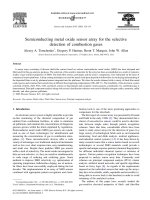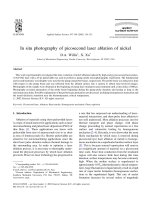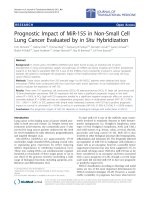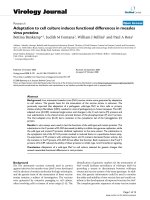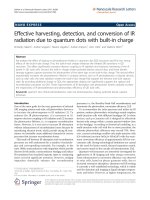Cell culture microchip with built in sensor array for in situ measurement of cellular microenvironment
Bạn đang xem bản rút gọn của tài liệu. Xem và tải ngay bản đầy đủ của tài liệu tại đây (4.65 MB, 149 trang )
CELL CULTURE MICROCHIP WITH BUILT-IN
SENSOR ARRAY FOR IN-SITU MEASUREMENT OF
CELLULAR MICROENVIRONMENT
ZHANG LIN
NATIONAL UNIVERSITY OF SINGAPORE
2007
CELL CULTURE MICROCHIP WITH BUILT-IN
SENSOR ARRAY FOR IN-SITU MEASUREMENT OF
CELLULAR MICROENVIRONMENT
ZHANG LIN
(B.Eng, ZJU, China)
A THESIS SUBMITTED
FOR THE DEGREE OF MASTER OF ENGINEERING
DEPARTMENT OF BIOENGINEERING
NATIONAL UNIVERSITY OF SINGAPORE
2007
i
Acknowledgement
First, I would like to express my deepest gratitude and heartfelt thanks to my
supervisor Assistant Professor Dieter W. TRAU for his on-going support, care,
encouragement, guidance and assistance throughout the course of this study. Without
his strong support and help, the thesis would not have been possible.
Then my special thanks go to Assistant Professor Partha Roy for his insightful advice
in oxygen detection and Associate Professor Michael J. McShane for his suggestions
about glucose sensing.
I owe a debt of gratitude to Mr. Lim Chee Tiong for his warm help in microfabrication,
and Mr. Tan Cherng Wen, Darren for his important assistance in cell culture. Their
help greatly steepened my learning curve enabling me to make rapid progress in these
two areas.
I wish to express my sincere appreciation to Dr. Shi Xing, Dr Sambit Sahoo and Mr.
Zheng Ye for their continual help in answering many of my questions. I also wish to
thank lab officers Ms Lee Yee Wei and Mr. Daniel Wong, for helping me process all
purchases of instruments and chemicals used in the project.
Deep thanks go to research fellows Dr Mak Wing Cheung, Martin, Ms Cheung Kwan
Yee, Queenie and all labmates at the Nanobioanalytics Lab: Ms Jiang Jie, Mr. Wang
Chen, Mr. Yue Mun Pun, Jeffrey, Mr. Bai Jianhao, Mr. Sebastian Beyer, Mr. Zhu
Qingdi and Mr. Martin Werner, for their support and assistance in daily research work.
ii
I owe my thanks to my friends in NUS: Mr. Xu Yingshun, Ms Jiang Shan, Mr. Wu
Wenzhuo, Mr. Teh Kok Hiong, Thomas, Mr. Hou Shengwei, Ms Wang Zhibo, Dr Li
Jian, Mr. Tan Chi Wei, Ms Sun Bingfeng, Mr. Kalyan Mynampati, Mr. Ng Tze Chiang,
Albert and Ms Tang Qianjun, for their generous support and help regard to both my
research work and my daily life. Extended thanks to Ms Kou Shanshan (NUS), Mr.
Sun Yuyang (NTU), Mr. Juejun Hu (MIT), Mr. Candong Cheng (Duke), Mr. Zhang
Rui (UA) and Mr. Lu Yuerui (Stanford) for all their kind help during my conference
stay in US.
My deepest acknowledgements go to the National University of Singapore (NUS) for
providing financial support for the project, the Institute of Materials Research &
Engineering (IMRE) for providing microfabrication facilities and the Micro Systems
Technology Initiative (MSTI) for providing softlithography and cell culture facilities.
Last but not least, I would like to thank my parents and all my family for their
understanding, support and love.
Zhang Lin, Charles
Singapore , Aug 2007
iii
Table of Contents
Acknowledgement ........................................................................................................... i
Table of Contents........................................................................................................... iii
Summary ....................................................................................................................... vii
Nomenclature.................................................................................................................. x
List of Figures................................................................................................................ xi
List of Tables ................................................................................................................ xv
Chapter 1 Introduction ............................................................................................... 1
Chapter 2 Literature Review ...................................................................................... 4
2.1 Microfluidics......................................................................................................... 4
2.2 Microfluidics and Cell Culture ............................................................................. 5
2.3 Fabrication of Microfluidic Device ...................................................................... 9
2.3.1 Photolithography and SU-8 ........................................................................... 9
2.3.2 Soft-lithography and PDMS ........................................................................ 10
2.4 Analysis of the Microenvironment ..................................................................... 13
2.4.1 The Difference of Microenvironment.......................................................... 13
2.4.1 Microbeads Based Analysis......................................................................... 17
2.4.2 Fluorescence Optical Sensing ...................................................................... 18
2.4.2.1 Fluorescence-based Glucose Sensor ..................................................... 18
2.4.2.2 Fluorescence-based Oxygen Sensor ..................................................... 22
2.4.2.3 Fluorescence-based pH Sensor ............................................................. 24
2.4.3 Fusion of Microfluidics and Optics ............................................................. 25
2.5 Summary ............................................................................................................. 26
iv
Chapter 3 Preliminary Study.................................................................................... 27
3.1 Fiber Optics Setup .............................................................................................. 27
3.2 Basic Fluorescence Calibration .......................................................................... 29
3.3 Simple Microchannel Fabrication....................................................................... 33
3.4 Summary ............................................................................................................. 34
Chapter 4 Design and Fabrication of Microchip .................................................... 35
4.1 Design of the Microchip ..................................................................................... 35
4.2 Design of the Photo Mask................................................................................... 39
4.2.1 Drawing Using AutoCAD ........................................................................... 39
4.3 Fabrication of Master Mold ................................................................................ 41
4.4 PDMS Molding................................................................................................... 48
4.5 Post Molding Processing .................................................................................... 53
4.5.1 Plasma Treatment ........................................................................................ 53
4.5.2 Thermal Aging............................................................................................. 53
4.6 Summary ............................................................................................................. 54
Chapter 5 Development of Optical Microsensors ................................................... 55
5.1 Development of Optical Glucose Sensor............................................................ 55
5.1.1 Aqueous Phase Sensor Calibration and Optimization ................................. 56
5.1.1.1 Comparison of Four Quencher/Donor Pairs ......................................... 57
5.1.1.2 Quenching Depth and Quenching Kinetics .......................................... 60
5.1.1.3 Ratio Optimization for Higher Glucose Sensitivity.............................. 62
5.1.2 Gel Matrix Phase Sensor Characterization .................................................. 65
5.1.3 Sensor Integration with Microchip .............................................................. 69
v
5.1.3.1 Immobilization and Encapsulation ....................................................... 70
5.1.3.2 Automation of Layer-by-Layer Coating ............................................... 73
5.1.3.3 Sensor Calibration and Photostability Test........................................... 76
5.2 Development of Optical pH Sensor .................................................................... 78
5.3 Development of Optical Oxygen Sensor ............................................................ 80
5.4 Summary ............................................................................................................. 83
Chapter 6 Sensing of Cellular Microenvironment.................................................. 84
6.1 Cell Culture......................................................................................................... 84
6.1.1 β-TC-6 Cell Culture in Flask ....................................................................... 84
6.1.2 β-TC-6 Cell Culture on Polystyrene Sheet .................................................. 87
6.2 Microchip System Assembly .............................................................................. 90
6.2.1 Sterilization.................................................................................................. 90
6.2.2 System Assembly......................................................................................... 91
6.3 On-chip Analysis of Cellular Microenvironment ............................................... 95
6.3.1 Measurement of Glucose ............................................................................. 95
6.3.2 Extra-cellular pH Sensing .......................................................................... 101
6.3.3 Oxygen Level Analysis.............................................................................. 102
6.4 Toxicity Study................................................................................................... 106
6.5 Summary ........................................................................................................... 107
Chapter 7 Conclusions and Recommendations..................................................... 108
7.2 Conclusions....................................................................................................... 108
7.2 Recommendations............................................................................................. 110
vi
Bibliography ............................................................................................................... 112
Appendices.................................................................................................................. 118
Appendix A
Microplate based Glucose Sensor Fabrication................................ 118
Appendix B
Microchip based Glucose Sensor Fabrication ................................ 119
Appendix C
Microchip based Oxygen Sensor Fabrication ................................. 120
Appendix D
Oxygen Plasma Treatment of PDMS Chip..................................... 121
Appendix E
Master Fabrication by Photolithography ........................................ 122
Appendix F
Micromolding through Soft Lithography ....................................... 124
Appendix G
β- TC-6 Cell Culture Related.......................................................... 125
Appendix H
Cellular Microenvironment Measurement...................................... 128
Appendix I
Mechanical Drawings of the Microchip ......................................... 131
Appendix J
International Conference Contribution ........................................... 132
vii
Summary
Microfluidics is the science and technology of systems that manipulate chemical or
biological processes in microliter or nanoliter scales, using channels with dimensions
of tens to hundreds of micrometers. Since its emergence in the late 1990s, it has
successfully made its way into many different research areas with microfluidics based
cell culture being one of its key applications that attract more and more attention. The
uniqueness about a microfluidic cell culture system is that it can mimic in-vivo cell
culture conditions and offer researchers the great opportunity in exerting a better
control over the cellular microenvironment both in space and in time. The challenge
that comes along with the opportunity is how to analyze this in-vivo like
microenvironment. The difficulty here is largely due to some fundamental differences
between the new cellular microenvironment under the microfluidics platform and that
under conventional cell culture conditions; these differences render the existing
detection methods developed for macroscale applications not applicable to the new
microscale situations. In an attempt to solve this problem, we designed and developed
a hybrid microchip system with integrated on-chip cell culture and cellular
microenvironment sensing capabilities.
The microchip features a double layer design: one microchannel layer intended for cell
culturing and one microtrench layer or the sensing layer intended for immobilization of
sensing materials. The microchip is fabricated through a modified photolithography
with a final micromolding using Poly Dimethyl Siloxane (PDMS).
viii
Three fluorescence based optical sensors for cellular sensing of pH, biological oxygen
level and glucose concentration are developed and successfully integrated with the
fabricated microchip. The optical glucose sensor is based on the competitive binding
between glucose and suitably labeled fluorescence compound to a common receptor
site; the fluorescence signal is directly related to the concentration of glucose through
the process of fluorescence resonance energy transfer (FRET). In our case, a sugar
binding protein Concanavalin A labeled with tetramethylrhodamine isothiocyanate
(TRITC) is used as the receptor; dextran labeled with fluorescein isothiocyanate (FITC)
is used as the glucose competitor. The oxygen sensor is based on oxygen quenching
the fluorescence of a ruthenium complex, where higher oxygen level means a lower
fluorescence signal. Finally, the pH sensor is based on the pH dependent dye FITC.
Matrix assisted layer-by-layer coating techniques are used in fabrication of these
sensors. Sensor calibration results show good sensitivity in the physiological range of
all the three mentioned parameters.
Culturing of β-TC-6 cells in the microchannel is successful and on-chip measurement
of cellular microenvironment using the integrated optical sensors is demonstrated.
Expected responses of sensors were observed during the measurement, showing the
sensors’ robustness in working in the real cell culture environment. The measurement
is in-situ, real time and reagentless, fulfilling all requirements of microscale sensing.
Cells in the microchannel show normal attachment and proliferation profiles,
indicating good biocompatibility of the system and sensors. The system also shows
good stability over time, great flexibility in customization for different applications
and points out a new way to ultimately bring cell culture and cell assay altogether.
ix
Results from this thesis have been presented at:
Conference:
BiOS, Photonics West 2007, San Jose, USA
Paper title:
PDMS microdevice with built-in optical biosensor array for on-site
monitoring of the microenvironment within microchannels
Conference:
3rd Annual Graduate Student Symposium 2006, NUS, Singapore
Paper title:
Beta-cyclodextrin/Rhodamine complex as a high efficient quencher in
FRET for the Concanavalin A based glucose optical sensing system
Journal paper: Lab-on-a-chip (in review)
Paper title:
Device
In-situ Measurement of Cellular Microenvironment in a Microfluidic
x
Nomenclature
PDMS
Poly Dimethyl Siloxane
FRET
Fluorescence Resonance Energy Transfer
FITC
Fluorescein isothiocyanate
TRITC
Tetramethylrhodamine isothiocyanate
LbL
Layer-by-Layer
Con A
Concanavalin A
PAH
Poly(allylamine hydrochloride)
PSS
Poly(sodium 4-styrenesulfonate)
DMEM
Dulbecco’s Modified Eagle’s Medium
FBS
Fetal Bovine Serum
PBS
Phosphate Buffer Solution
IPA
Isopropyl Alcohol
MEMS
Micro-Electro-Mechanical Systems
GOX
Glucose Oxidase
PEG
Polyethylene glycol
UV
Ultra Violet
SU-8
SU-8 Negative Photoresist
mM
millimolar
NI
National Instrument
CCD
Charge Coupled Device
PMT
Photomultiplier Tube
xi
List of Figures
Figure 2.1 Various microfluidic systems for different applications
5
Figure 2.2 Photolithography for a negative photoresist
10
Figure 2.3 PDMS micromolding with SU-8 master mold
11
Figure 2.4 (1) Non-homogenous microenvironment in microscale cell culture
15
Figure 2.4 (2) Homogenous cellular environment in macroscale cell culture
15
Figure 2.5 (1) Molecular model of Conanavalin A in its tetrameter form
20
Figure 2.5 (2) Molecular model of dextran, member of the polysaccharide family
20
Figure 2.6 Fluorescence Resonance Energy Transfer
21
Figure 2.7 Glucose sensing mechanism for Con A-FITC / Dextran-TRITC
22
Figure 2.8 Detection mechanism of oxygen quenching
23
Figure 2.9 Calibration curves of pH dependent fluorescence dyes
24
Figure 3.1 Optical probe based fluorescence setup
27
Figure 3.2 Fiber optics setup with inline filters
28
Figure 3.3 (1) Con A-FITC calibration
29
Figure 3.3 (2) Regression curve of the calibration quenching curve
30
Figure 3.4 Quenching profile of Con A-FITC by Dextran-TRITC
31
Figure 3.5 Quenching spectrums for different quencher/donor ratios
32
Figure 3.6 SU-8 mold with single layer straight microchannels
33
xii
Figure 4.1 Initial proposed microfluidic system setup
35
Figure 4.2 (1) Simulated gel pads on a piece of glass slide
36
Figure 4.2 (2) Single channel microchip (3) Assembly of the two parts
36
Figure 4.3 Series of micro-trenches at the bottom of a microchannel
37
Figure 4.3 Insert: Zoom-in image for one micro-trench
37
Figure 4.4 System assembly under the new design
38
Figure 4.5 (1) Mask design for microchannels
40
Figure 4.5 (2) Mask design for micro-trenches
40
Figure 4.6 Process flow for SU-8 2000 photoresist
41
Figure 4.7 Positioning wafer on the Spin Coating System, CEE 100 (CEE)
43
Figure 4.8 Mask Aligner (SUSS MicroTec) for substrate alignment and exposure
43
Figure 4.9 Double layer SU-8 master mold
45
Figure 4.10 KLA-Tencor Surface Profiler
46
Figure 4.11 Characterization of the SU-8 master mold
47
Figure 4.12 Surface silanization of the SU-8 mold
48
Figure 4.13 Mixing PDMS polymer base and curing agent
49
Figure 4.14 Casting the PDMS mixture onto the master mold
50
Figure 4.15 Degassing
50
Figure 4.16 PDMS chip ready for use
51
Figure 4.17 (1) Microchannel of a PDMS chip
51
Figure 4.17 (2) Microchannel and microtrench of the PDMS chip
52
xiii
Figure 5.1 FLUOstar OPTIMA microplate reader
56
Figure 5.2 Fluorescence quenching of Dextran-FITC by Con A –TRITC
61
Figure 5.3 Deeper quenching induced by providing extra calcium ions
62
Figure 5.4 (1) Ratio optimization for highest glucose sensitivity
63
Figure 5.4 (2) Normalized ratio optimization for highest glucose sensitivity
64
Figure 5.5 Glucose sensor calibration based on quencher ratio 32:1
64
Figure 5.6 Fluorescence characterization of LbL coating
66
Figure 5.7 (1) Agarose matrix based glucose sensor calibration
67
Figure 5.7 (2) Calibration for the physiological glucose range
68
Figure 5.8 Process flow for PMDS chip based glucose sensor fabrication
70
Figure 5.9 Snapshots of a microtrench during immobilization & LbL coating
72
Figure 5.10 (1) Automated Layer-by-Layer coating setup
73
Figure 5.10 (2) Zoom in image for 5.10 (1)
74
Figure 5.10 (3) Software interface of the control system
74
Figure 5.11 (1) Image of microchannel without LbL coating
75
Figure 5.11 (2) Image of PAH-FITC coated channel after washing for 5 hrs
75
Figure 5.12 Microtrench glucose sensor calibration
76
Figure 5.13 Calibration of photo bleaching under constant excitation
77
Figure 5.14 Fluorescence image of a microtrench pH sensor
78
Figure 5.15 Calibration of microtrench pH sensor
79
Figure 5.16 Ruthenium complex mixtures ready for sensor immobilization
81
Figure 5.17 (1) Fluorescence image of microtrench right after degassing
82
Figure 5.17 (2) Fluorescence image of microtrench 5hrs after degassing
82
Figure 5.18 Calibration of ruthenium oxygen sensor
82
xiv
Figure 6.1 (1) β-TC-6 cells in T-75 flask, 3 days after sub-culture X 100
85
Figure 6.1 (2) β-TC-6 cells in T-75 flask, 3 days after sub-culture X 200
85
Figure 6.1 (3) β-TC-6 cells in T-75 flask, 6 days after sub-culture X 100
86
Figure 6.2 Trypan blue based viable cell counting
87
Figure 6.3 Cell culture on a polystyrene sheet
88
Figure 6.4 (1) Cells on the polystyrene surface
89
Figure 6.4 (2) Cells on the Petri dish surface
89
Figure 6.5 Microchip system pre-assembly
92
Figure 6.6 Complete perfusion system for microchip cell culture
93
Figure 6.7 Microchip cell culture system on the microscope platform
95
Figure 6.8 Real Time fluorescence imaging for glucose microsensors
96
Figure 6.9 (1) Phase contrast image of glucose sensor microtrench
97
Figure 6.9 (2) Red fluorescence image of glucose sensor microtrench
97
Figure 6.10 Fluorescence image under different cell media perfusion rate
97
Figure 6.11 (1) Image capturing using Nikon ACT-1 software
100
Figure 6.11 (2) Quantification of fluorescence intensity using Image-Pro Plus
100
Figure 6.12 Bright field image and fluorescence image of the pH microsensor
101
Figure 6.13 (1) Images of the oxygen microsensor under flow rate of 2 µl/min
102
Figure 6.13 (2) Images of the oxygen microsensor under flow rate of 0.1 µl/min
102
Figure 6.14 Oxygen quenching under varied flow rate
104
Figure 6.15 Oxygen gradient in the direction of the flow
105
Figure 6.16 (1) Cells close to microtrench at 12 hrs of media perfusion
106
Figure 6.16 (2) Cells close to microtrench at 24 hrs of media perfusion
106
xv
List of Tables
Table 2.1 Categorized microfluidic cell culture systems according to cell types
Table 5.1 Chemical combinations for glucose sensing
8
57
1
Chapter 1
Introduction
Since the first transistor was invented at Bell Laboratories in 1947, technology has
taken on the express of miniaturization and integration. Shrinking in size is the most
common trend shared by most technologies. It is microelectronics when it comes to
electrons and microfluidics when it comes to fluids.
Microfluidics deals with the behavior, precise control and manipulation of microliter
and nanoliter volumes of fluids. It is a multidisciplinary field interfacing with physics,
chemistry, microtechnology and biotechnology, with practical applications to the
design of systems in which such small volumes of fluids will be used. Microfluidics
emerged only in the 1990s and has become increasingly popular in recent years largely
because of the development of the softlithography based fabrication techniques and the
availability of a new elastomeric material Poly Dimethyl Siloxane (PDMS).
Advancements in these two areas make microfluidic devices with complex features can
be easily fabricated in a common lab requiring neither sophisticated instrumentation
set-up nor complicated processing.
Microfluidics, since its emergence, has been revolutionizing many research areas
including molecular biology, cell biology and medical diagnosis. The basic idea of
microfluidics is to integrate assay operations such as detection, as well as sample pre-
2
treatment and sample preparation on one chip. One key application of microfluidics is
cell culture in microfluidic devices, challenging the conventional Petri dish and culture
flask based cell culture methodology. Microfluidics based cell culture systems can
provide a level of control over the cell culture microenvironment that cannot be
achieved in traditional culture conditions. Microfluidics can reproducibly produce
confined and well-defined systems such as microchannels on the cellular length scale
(~5 μm – 500 μm) and can incorporate complex designed topographies, densities of
extracellular matrix signaling molecules with the unique ability to mimic in-vivo
solution flow. These desirable properties of microfluidics based cell culture systems
have attracted a large number of researchers from different research areas such as
microfluidics, cell biology and bioanalytics. Up to date, many microfluidic systems
have been built for culturing different cell lines, and their strong capabilities in
simulating in-vivo cell culture and in giving more control both temporally and spatially
over the cell culture microenvironment are successfully demonstrated.
However, analysis of the cellular microenvironment under the microfluidic platform
remains an issue to be addressed. The difficulty here is largely due to some
fundamental differences between the new cellular microenvironment under
microfluidics and that under traditional cell culture conditions. For instance, the ultra
small volume of the sample manipulated in microfluidics makes any centrifuge tube
(in the milliliter volume range and above) based assay literally impossible; and the
dominant laminar flow property unique to microfluidics based systems may lead to
totally failures of those detection methods developed under conventional macroscale
systems where convection is dominant force governing the behaviors of fluids.
3
In this study, an attempt was made to solve these problems by designing and
developing a hybrid microchip system enabling cell culture with on-chip cellular
microenvironment sensing capability. This was achieved by merging different
technologies including microfabrication, fluorescence optical sensing and advanced
biomaterial encapsulation techniques. A modified photolithography method was
developed to fabricate a double layer microfluidic device, with the microchannel layer
intended for cell culture while the microtrench layer for immobilization of sensing
biomaterials. Fluorescence based optical sensing was chosen for building up sensors,
considering high sensitivity the fluorescence method can offer and the easy integration
with the device. Matrix assisted layer-by-layer coating technique was used for the
encapsulation of these sensors. β-TC-6 cell was used as the cell line cultured in the
final microfluidic device and in-situ measurement of three parameters including pH,
oxygen and glucose concentration in the cellular microenvironment was demonstrated.
The thesis is organized into seven chapters followed by references and appendices. The
present chapter is a brief introduction to the background and the study to be conducted.
Chapter 2 is the literature survey where a detailed description of the technological
background and relevant information are given. Chapter 3 refers to some preliminary
study followed by chapter 4 where the design and fabrication of the microchip is given
in detail. Development of three different optical microsensors on the microchip is
illustrated in chapter 5. Chapter 6 describes the final system assembly and on-chip
measurement of the cellular microenvironment. Chapter 7 presents the conclusion and
some recommendations for future study.
4
Chapter 2
Literature Review
2.1 Microfluidics
Microfluidics is the science and technology of systems that manipulate chemical or
biological processes in nanoliter (nL) or microliter (µL) scales, using channels with
dimensions of ten to hundreds of micrometers [1]. In practice, a microfluidic device
can be identified by the fact that it has one or more channels with at least one
dimension in the micrometer range. The downscale in size offers such microfluidic
systems a number of obvious advantages: low reagent consumption, high throughput
and short time for analysis. Other less obvious characteristics which are not accessible
on the macroscopic scale include laminar flow, high surface to volume ratio and
improved control over experimental conditions both in space and in time [2]. Due to its
numerous advantageous properties, the technology platform based on microfluidics has
undergone a tremendous development during the past decade. From being a
specialized area of research, it has now grown to an interdisciplinary field engaging
hundreds of research groups along with several companies worldwide. To date,
microfluidic systems have successfully made its way into chemical & biological
analysis [3], cell biology & tissue engineering [4], drug delivery [5], neuron science [2]
and even system biology [6]. Figure 2.1 shows various applications of microfluidic
systems.
5
Figure 2.1 Various microfluidic systems from Syrris-dolomite
2.2 Microfluidics and Cell Culture
Among aforementioned different applications, the use of microfluidics for cellular
study is of particular interest given the fact that microfluidic systems are right at the
same characteristic length scale as most cells are.
Cell culture is a key step in cell biology, tissue engineering, biomedical engineering
and pharmacokinetics and a prerequisite for virtually all cell based studies. The
conventional culture dish / flask based cell culture methodology has been under use for
more than a century with no fundamental change. Although such in vitro cell culture
technique is widely used both in academic research and in industries, the lack of
6
experimental control over the culture microenvironment has become a big concern.
Here we define the microenvironment as the immediate surroundings of a cell with a
spatial distance comparable to the characteristic length scale of cultured cells. Cell is
powerfully modulated by its microenvironment which is comprised of different local
extracellular cues including soluble signaling molecules, dissolved gases, the
chemistry and mechanics of the insoluble extracellular matrix proteins, and the actions
of neighboring cells. Cells respond heavily to spatial and temporal variations in these
environmental cues [7]. However, most cell based studies are based on cells grown in
vitro in a static and macroscale environment which is entirely different from the real
environment of biological systems. Therefore, in-vivo cell culture microenvironment is
highly desirable.
Microfluidic systems is found to be able to provide a level of control over the cell
culture microenvironment that cannot be achieved in traditional culture conditions
such as in a Petri dish or cell culture flask. This is because microfluidic systems can
reproducibly produce confined and well-defined systems on the cellular length scale
(~5 μm – 500 μm) and can incorporate complex designed topographies, densities of
extracellular matrix signaling molecules, nonrandom organization of cells of different
types, and the ability to mimic in vivo solution flow. Over the years, various
microfluidic cell culture systems have been developed and their capability in creating
the desirable in-vivo cell culture environment has been demonstrated.
In general, microfluidic cell culture systems fall into two major categories: twodimensional system and three-dimensional system. Most microfluidic cell culture
systems adapt a two-dimensional culture method because it is easy to control a single
7
well defined cell type while simplifying the manipulation of large quantities of cells
and the direct optical characterization of the cellular behavior using a fluorescence
microscope. In contrast, a three-dimensional cell culture system has been developed
for a better reproduction of the in-vivo like microenvironment. Several cell lines have
been successfully cultured in both two-dimensional and three-dimensional microfluidic
cell culture systems and a good response of well controlled cell attachment, spreading
and growth is demonstrated [8-11]. Using a two dimensional microfluidic system,
Cotman et al. patterned primary rat neurons via a simple plasma-based dry etching
method and the system was maintained up to six days inside a microfluidic device [12].
Eric et al. presented a three dimensional Poly Dimethyl Siloxane (PDMS) microdevice
for culturing Hep G2 cells and it was demonstrated the cells could be kept in good
condition for around ten days with a completely closed perfusion system [11, 13]. The
successful proliferation and differentiation of human neuronal stem cells were also
observed under the microfluidic platform described in [14]. A more complete list of
microfluidic cell culture systems experimentally demonstrated so far is shown in Table
2.1 [7].
Microfluidic cell culture systems, leveraging on their unique capability in creating
more in-vivo like cellular microenvironment, are breaking new ground for cell culture;
yet they also bring new challenges in accurate detecting, sensing and monitoring such
in-vivo like environment. As cell culture shifts from flask and Petri dish into the
microchannels, new cell culture analytical methods with minimal perturbation to the
cellular microenvironment are highly needed.
8
Table 2.1 Categorized microfluidic cell culture systems according to cell types


